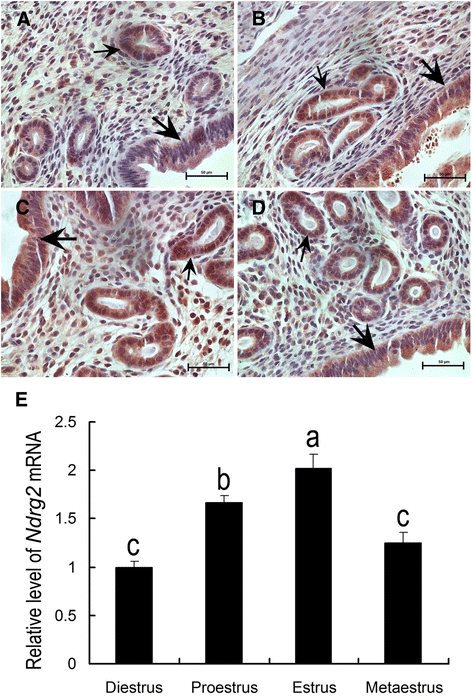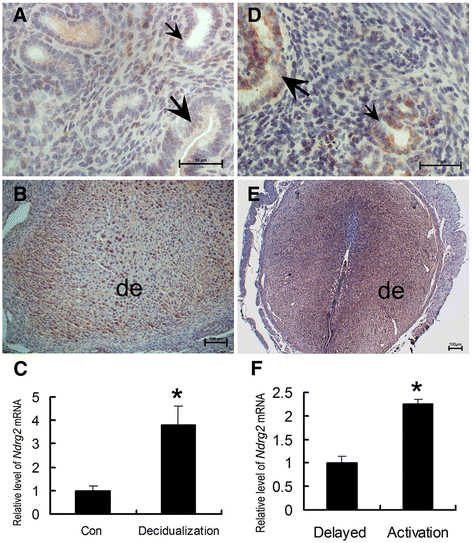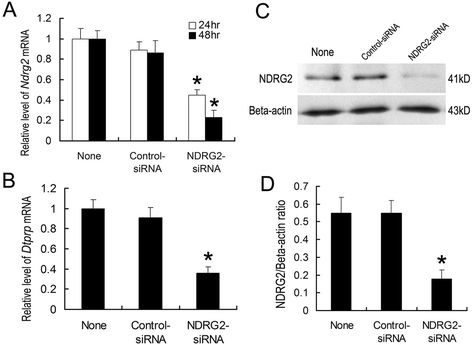Uterine NDRG2 expression is increased at implantation sites during early pregnancy in mice, and its down-regulation inhibits decidualization of mouse endometrial stromal cells
- PMID: 26013399
- PMCID: PMC4447025
- DOI: 10.1186/s12958-015-0047-7
Uterine NDRG2 expression is increased at implantation sites during early pregnancy in mice, and its down-regulation inhibits decidualization of mouse endometrial stromal cells
Erratum in
-
Erratum: Uterine NDRG2 expression is increased at implantation sites during early pregnancy in mice, and its down-regulation inhibits decidualization of mouse endometrial stromal cells.Reprod Biol Endocrinol. 2015 Aug 29;13:98. doi: 10.1186/s12958-015-0089-x. Reprod Biol Endocrinol. 2015. PMID: 26319599 Free PMC article. No abstract available.
Abstract
Background: N-myc down-regulated gene 2 (NDRG2) is a tumor suppressor involved in cell proliferation and differentiation. The aim of this study was to determine the uterine expression pattern of this gene during early pregnancy in mice.
Methods: Uterine NDRG2 mRNA and protein expression levels were determined by RT-PCR and Western blot analyses, respectively, during the peri-implantation period in mice. Immunohistochemical (IHC) analysis was performed to examine the spatial localization of NDRG2 expression in mouse uterine tissues. The in vitro decidualization model of mouse endometrial stromal cells (ESCs) was used to evaluate decidualization of ESCs following NDRG2 knock down by small interfering RNA (siRNA). Statistical significance was analyzed by one-way ANOVA using SPSS 19.0 software.
Results: Uterine NDRG2 gene expression was significantly up-regulated and was predominantly localized to the secondary decidual zone on days 5 and 8 of pregnancy in mice. Its increased expression was associated with artificial decidualization as well as the activation of delayed implantation. Furthermore, uterine NDRG2 expression was induced by estrogen and progesterone treatments. The in vitro decidualization of mouse ESCs was accompanied by up-regulation of NDRG2 expression, and knock down of its expression in these cells by siRNA inhibited the decidualization process.
Conclusions: These results suggest that NDRG2 might play an important role in the process of decidualization during early pregnancy.
Figures






Similar articles
-
Uterine Expression of NDRG4 Is Induced by Estrogen and Up-Regulated during Embryo Implantation Process in Mice.PLoS One. 2016 May 13;11(5):e0155491. doi: 10.1371/journal.pone.0155491. eCollection 2016. PLoS One. 2016. PMID: 27175791 Free PMC article.
-
Increased Expression of NDRG3 in Mouse Uterus During Embryo Implantation and in Mouse Endometrial Stromal Cells During In Vitro Decidualization.Reprod Sci. 2018 Aug;25(8):1197-1207. doi: 10.1177/1933719117737843. Epub 2017 Nov 2. Reprod Sci. 2018. PMID: 29096585
-
Progesterone and DNA damage encourage uterine cell proliferation and decidualization through up-regulating ribonucleotide reductase 2 expression during early pregnancy in mice.J Biol Chem. 2012 May 4;287(19):15174-92. doi: 10.1074/jbc.M111.308023. Epub 2012 Mar 8. J Biol Chem. 2012. PMID: 22403396 Free PMC article.
-
Cell cycle regulatory control for uterine stromal cell decidualization in implantation.Reproduction. 2009 Jun;137(6):889-99. doi: 10.1530/REP-08-0539. Epub 2009 Mar 23. Reproduction. 2009. PMID: 19307426 Review.
-
Progress on the Role of Estrogen and Progesterone Signaling in Mouse Embryo Implantation and Decidualization.Reprod Sci. 2023 Jun;30(6):1746-1757. doi: 10.1007/s43032-023-01169-0. Epub 2023 Jan 24. Reprod Sci. 2023. PMID: 36694081 Review.
Cited by
-
Uterine Expression of NDRG4 Is Induced by Estrogen and Up-Regulated during Embryo Implantation Process in Mice.PLoS One. 2016 May 13;11(5):e0155491. doi: 10.1371/journal.pone.0155491. eCollection 2016. PLoS One. 2016. PMID: 27175791 Free PMC article.
-
METTL3-dependent m6A methylation facilitates uterine receptivity and female fertility via balancing estrogen and progesterone signaling.Cell Death Dis. 2023 Jun 3;14(6):349. doi: 10.1038/s41419-023-05866-1. Cell Death Dis. 2023. PMID: 37270544 Free PMC article.
-
Erratum: Uterine NDRG2 expression is increased at implantation sites during early pregnancy in mice, and its down-regulation inhibits decidualization of mouse endometrial stromal cells.Reprod Biol Endocrinol. 2015 Aug 29;13:98. doi: 10.1186/s12958-015-0089-x. Reprod Biol Endocrinol. 2015. PMID: 26319599 Free PMC article. No abstract available.
References
Publication types
MeSH terms
Substances
LinkOut - more resources
Full Text Sources
Other Literature Sources
Molecular Biology Databases

